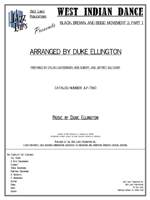BLACK, BROWN, AND BEIGE - MOVEMENT 2, PART 1: WEST INDIAN DANCE
Arranged by Duke Ellington, Prepared by Dylan Canterbury, Rob DuBoff, and Jeffrey Sultanof

Cat #: JLP-7360
$75.00This item usually ships within 1 business day.
Questions?
Please call +1-518-587-1102 or email us.
Edition: Jazz Big Band Arrangement
Description: Swing - Difficult
Publisher: Jazz Lines Publications
The initial tone of the first part of "Brown" is surprisingly militant, with Sonny Greer providing a crisp marching band style cadence up front. A brief minor version of the classic folk song "The Girl I Left Behind Me" in the clarinet leads into more original territory, with a syncopated riff in the brass setting up a Caribbean-influenced groove at measure 15. This groove underpins a melody that is largely performed in the woodwinds during this section, although a punchy brass riff at measure 23 serves as a nice monotony-breaker.
The return to a more familiar swing feel at measure 47 is marked by an Ellington trademark: the woodwinds emulating the sound of a train whistle. Although the woodwinds continue to dominate the melody duties at measure 51, a trio of two plunger muted trumpets and one trombone provide a surprisingly aggressive counterpoint. Things become even more complex at measure 63, where the non-plunger trumpets engage in some quickly traded solos. Underneath this, the Caribbean rhythm from the beginning of the piece is reiterated by the trombones.
The plunger brass trio returns at measure 75, playing the same role as counter line to the woodwinds as before. This pattern continues until measure 95, where the final riff of the melody is tagged in the woodwinds. The volume decreases gradually until suddenly shooting upwards for what seems to be the arrangement's concluding fanfare - only for Harry Carney's baritone saxophone to be left alone to play a brief rubato solo.
A punchy (and harmonically altered) reference to "Yankee Doodle" in the brass sets up a more relaxed tempo at measure 106. Said relaxed tempo is only a brief respite, however, as following a rubato baritone sax and clarinet duet at measure 110, the woodwinds perform a dramatically swelling and ascending line. As the line continues, each woodwind drops out until only the clarinet is left on a single, solitary F#. The tempo immediately kicks back in for the final four bars of the arrangement, with a brass fanfare and thunderous drum cadence setting up the next movement.
2 Alto Saxophones
Clarinet
Tenor Saxophone
Baritone Saxophone
4 Trumpets
3 Trombones
Guitar
Piano
Bass
Drums
Trombone 1: Db5







![MOOCHE, THE [DOWNLOAD]](https://www.ejazzlines.com/wp-images/product/thumbnail/28046-s.jpg)

